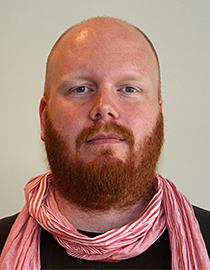Björn Morén

My Earth Science career began in 2005, with the Bachelor’s Programme in Biology-Earth Sciences at Stockholm University. Almost from beginning I realised that, for me, the geosciences were more interesting and therefore I decided to focus more on that side of the study programme. In the end I switched specialisation from Biology-Earth Science to Earth Science. My Bachelor’s thesis consisted of a tephrochronological study of a lake in western Småland in the south-west of Sweden, where I tried to constrain the Last Glacial / Interglacial transition in the area.
For my Master’s studies, I attended the Master’s Programme in Glaciology and Polar Environments, also at Stockholm University. During my Master’s degree project I investigated the palaeoglaciology of the central Tibetan Plateau, centred on the Tanggula Shan. A detailed mapping of the area’s glacial geomorphology, through use of satellite imagery and digital elevation models, was combined with existing cosmogenic nuclide dates around the Tanggula Shan.
After completing my Master’s, I worked with prospecting in Sweden and Finland and as a research assistant at Stockholm University. As a research assistant I was involved in mapping the glacial geomorphology of the Tian Shan in Central Asia, using mostly the same methods I had previously used during my Master’s project.
Project Description
My project will focus on the north-eastern part of the North Sea, with special attention on the Norwegian Channel and its palaeo-ice stream, the Norwegian Channel Ice Stream. I will use seismic profiles, bathymetric data, sediment cores, and numerical modelling to provide a refined glacial history of the Norwegian sector of the North Sea during the last deglaciation.
The PhD project consists of four sub-projects, dealing with various aspects of the deglaciation. The first sub-project will use TOPAS, sediment stratigraphy, radiocarbon dates, and geomorphological features to construct a deglaciation history of the Norwegian Channel. The second sub-project will aim to develop a conceptual model for grounding-zone-wedge formation in the Norwegian Channel, through analyses of the wedges’ spatial extent and internal composition. The third sub-project will use the data gained from the first two papers, as well as prior data, to numerically model the behaviour of the NCIS during the last 30 ka. The modelling will be carried out with researchers from Durham University, during a planned secondment there. The fourth and final sub-project will combine the existing data and the new data from the three sub-projects to create a refined glacial history of the North Sea, together with Elena Grimoldi who will be working on the western part of the North Sea.
GLANAM Output
LATEST NEWS
GLANAM NEWSLETTERS
- GLANAM Newsletter 13 – October 2016
- GLANAM Newsletter 12 – August 2016
- GLANAM Newsletter 11 – June 2016
- GLANAM Newsletter 10 – April 2016
- GLANAM Newsletter 9 – February 2016
- GLANAM Newsletter 8 – December 2015
- GLANAM Newsletter 7 – October 2015
- GLANAM Newsletter 6 – August 2015
- GLANAM Newsletter 5 – June 2015
- GLANAM Newsletter 4 – April 2015
- GLANAM Newsletter 3 – February 2015
- GLANAM Newsletter 2 – April 2014
- GLANAM Newsletter 1 – November 2013
